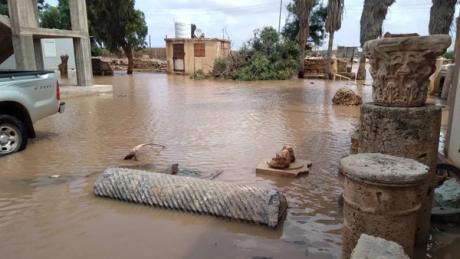
On Sunday 10 September, Storm Daniel devastated the eastern coastal cities of Libya, killing at least 4,000 people, leaving 9,000 missing and displacing more than 40,000 others, according to the UN humanitarian agency OCHA.As those in the North African country mourn and begin to assess the full extent of the destruction, archaeologists have discovered new historic remains and begun the daunting task of recording the damage to heritage sites.The disaster was unprecedented in Libya and its impact on heritage sites in the Cyrenaica region is gradually emerging as infrastructures and access roads are restored.A marble statue exposed by the floods in CyreneIn the Unesco World Heritage site of Cyrene, a city originally founded by Greek settlers and Romanised in 74BC, at least one marble statue has been unearthed. It was discovered on the site’s southern area at the Temple of Demeter, constructed in 490BC. Flooding continues to affect the area.About 150km west of Cyrene in the Mediterranean coastal city of Ptolemais—established as a Greek settlement in the 7th century BC and transformed during the Hellenistic period—a marble column and walls have been discovered on the beach. The city’s small museum, Ptolemais Museum, which houses precious objects including statues and mosaic floors from the Roman and Greek periods, has flooded.Tocra, the site of the ancient city of Taucheira again founded by the Greeks and located about 40km west of Ptolemais, has lost parts of its historic coastal wall.The coastal wall in TocraThe city of Derna, 100km east of Cyrene, bore the brunt of the destruction when two of the city’s damns collapsed and caused floods of what has been described as “biblical proportions”. This saw buildings completely wiped out and left masses of bodies scattered in streets and the sea.The historic town centre has been severely impacted, with the Old Mosque of Derna or Jami’ al-Atiq—originally built in 1656 by the Ottoman governor Muhammad bin Al Haj Mahmoud Bay Al Qurmanli and rebuilt between 2001-05—levelled completely with the ground.“It’s a disaster, simply a disaster… everything disappeared in ten minutes, it’s very painful,” Ahmad Emrage, an assistant professor at the department of archaeology at the University of Benghazi in northeastern Libya, and consultant to the Libyan department of antiquity, told The Art Newspaper.Now that the roads are reopening, Emrage and his colleagues have a plan in place to begin surveying the sites by next week in order to determine a plan of action.Although the flooding at Cyrene has not caused the havoc witnessed in Derna, the continuous presence of water has concerned experts that it could damage its key monuments’ structural integrity, which include temples, sanctuaries, an amphitheatre and tombs.Located on the edge of an escarpment, close to the modern town of Shehat, Cyrene’s ancient drainage system consists of channels designed to move water away from its buildings. The scale of the storm, however, has blocked the system.“Those channels are completely filled with water [have] overflow[ed],” says Emrage who says the authorities in the area are hard at work trying to repair the damage and drain the area. It had already been deemed so fragile as to have been placed, in 2016, on Unesco’s World Heritage list of endangered sites.Similarly, in Ptolemais, plans are being made to remove water and mud from its landmarks. The city is home to several heritage treasures such as Roman and Byzantine baths, well preserved insulae containing large peristyle houses (built in the Hellenistic period and enlarged in the late Roman period), a Roman amphitheatre and other theatres.Emrage says mud has covered the houses’ marble floors and mosaics which has potential to cause damage and requires a delicate cleaning process. Additionally, historic remains have been displaced in the area making it challenging for archaeologists to identify their origins.“It will be a huge clean up job. A lot of work has to be done,” Emrage says.A Roman column in Ptolemais uncovered by the floodingClimate change has been viewed as a significant contributor to the severity of the storm and a major threat to Libya’s heritage sites, many of which are located on the seafront.David Mattingly, professor of Roman archaeology at the University of Leicester who has spent more than 40 years working with Libyan heritage, tells The Art Newspaper: “One of the things that stuck me about this was the scale of the storm, it was pretty unprecedented in my lifetime in Libya but this may become more recurrent in the next decades.”Mattingly is a lead on the endangered archaeology of North Africa and the Middle East (EAMENA) project, which was set up in 2015 to respond to the increasing threats to archaeological sites in these regions. One aspect of the project—jointly launched by Oxford, Leicester and Durham universities in the UK—focuses on the threats of climate change on heritage sites and seeks to develop solutions to protect them.“Increasingly we are trying to model the impacts of climate change. Our interests are particularly in learning the lessons from what has happened and thinking about how we can assist the Libyan authorities in managing future threats and future damage,” Mattingly says.The modelling is based on a machine learning technique, referred to as automated change detection, which will compare satellite images from before and after an event and model it against archaeological sites on their database to identify which would face potentially significant risks.“Any time there are floods causing gullying, washing away soil then there is a danger of sites becoming more exposed and damaged,” Mattingly says.EAMENA had already planned to send a team to train Libyan heritage staff on the project’s predictive modelling in October. However, Mattingly says that given the current situation they will be discussing possible amendments to planned work with their Libyan collaborators to respond to the damage caused by the recent storm in select areas.“There is a huge campaign by the international community to help Libya protect its cultural heritage,” says Emrage, who says he has spent the last week receiving calls of support from his international colleagues.Logistical support, too has come from the Maritime Endangered Archaeology Project (MarEA) based at Ulster University and University of Southampton, also in the UK. The two institutions are collaborating with the department of antiquity Cyrenaica and the university of Benghazi, and have also offered financial and technical assistance.“The climate is changing and this is just the beginning. It’s a global issue,” says Emrage. “We have lots of cultural heritage sites located on the sea so we have to do something to protect them before they are gone forever.”Flooding inside the Ptolemais museumThe disaster comes in the wake of a turbulent era for Libya. The civil war that broke out when de facto leader Muammar Gaddafi was removed in 2011—after four decades of rule—left the country’s east and west politically divided and ruled by two separate governments, each backed by different militias. Before 2011, Libya, which has five Unesco World Heritage sites, was growing in popularity among international travellers.“Those sites are still there and have a potential to become important again,” says Mattingly.Aid organisations, meanwhile, have been battling to address the broader devastation caused by the floods. International Federation of Red Crescent (IFRC), meanwhile, announced last week an emergency appeal for 10m SFr (around $11m) to assist with the relief efforts in Libya.“The humanitarian crisis is catastrophic. It needs collective international support to be able to respond to this crisis,” Basheer Omar, International Committee of the Red Cross (ICRC) spokesperson in Libya tells The Art Newspaper.Omar says there is an urgent need for emergency shelters, food assistance, communication equipment, search and rescue equipment, medical assistance, four-wheel drive cars, solar panels, body bags and support for managing the dead bodies to help the impacted areas.“It is beyond the capacity of ICRC and the local authorities so we call for international support,” says Omar, who also warned that in Derna the floods had displaced explosive remnants of war that increased risk of further loss of life.


























